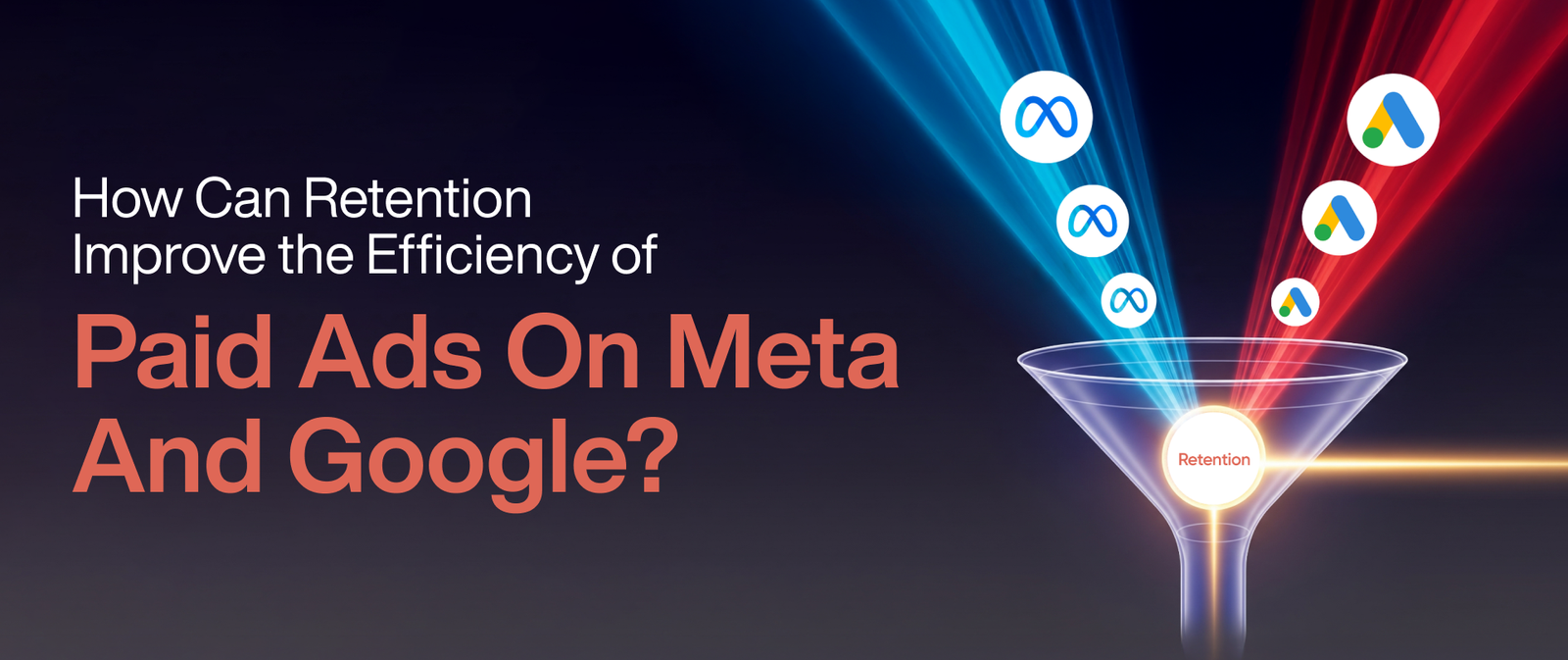How Can Retention Improve the Efficiency of Paid Ads on Meta and Google?

Paid advertising on Meta and Google remains a critical growth lever for DTC brands. However, for many 7-8 figure eCommerce brands, rising customer acquisition costs (CAC) make scaling increasingly expensive. The solution is not just spending more but leveraging retention to improve the efficiency of your paid ad campaigns.
Retention marketing and paid advertising are often treated as separate strategies, but when integrated, they create a powerful synergy that reduces CAC, increases ROI, and drives sustainable growth. In this guide, we will explore how retention impacts paid ad performance, which metrics matter most, and how DTC brands can implement expert-level strategies to maximize efficiency.
Why Paid Ads Alone Are Not Enough
Paid ads on platforms like Meta and Google are excellent for driving new customers, but they have inherent limitations
- Rising CAC: Increased competition and privacy changes (iOS updates, GDPR, CCPA) have made clicks more expensive
- Ad fatigue: Audiences become less responsive over time, reducing ad efficiency
- One-time buyers: Without retention, most acquired customers may never return, forcing constant reinvestment in ads
These challenges highlight why acquisition-focused campaigns alone cannot scale efficiently. By integrating retention strategies, brands can amplify the value of every ad dollar spent
How Retention Directly Boosts Paid Ad Efficiency
Retention marketing improves paid ad efficiency in multiple ways
1. Increasing Customer Lifetime Value (CLV)
Retention ensures that customers return for multiple purchases. Higher CLV means that the effective CAC decreases because every ad dollar is now spread across multiple transactions instead of just one
Example: If your CAC is $50 and a new customer makes only one purchase worth $75, your margin is thin. If retention strategies encourage that customer to make three purchases, each ad dollar effectively costs $16
Impact on Meta and Google Ads: Higher CLV allows brands to bid more aggressively on paid channels while maintaining profitability, making campaigns more competitive and scalable
2. Improving Audience Targeting
Retention data provides insights into customer behavior, product preferences, and purchase cycles. This data can be used to build
- Lookalike audiences on Meta: Targeting new users with similar characteristics to your best customers
- Custom intent audiences on Google: Retargeting users who are most likely to convert based on historical purchase data
By leveraging retention insights, paid campaigns can focus on high-value segments, reducing wasted ad spend and improving conversion rates
3. Reducing Dependence on Paid Acquisition
Retention reduces the percentage of revenue you need to generate through ads. Each returning customer requires little to no additional ad spend. Over time, this creates a compounding effect
- More revenue comes from repeat buyers, which frees up budget for smarter ad campaigns
- Paid ads can focus on scaling new customer acquisition while retention-driven sales cover operating costs
This means retention lowers CAC indirectly by generating more revenue per customer without additional paid investment
4. Enhancing Ad Creative and Messaging
Retention insights can inform creative strategy on Meta and Google
- Highlight products or bundles that resonate with repeat customers
- Use testimonials or reviews from loyal buyers to improve ad credibility
- Promote loyalty programs or subscription options to encourage first-time buyers to return
Ads backed by real retention data convert better because they are aligned with proven customer behaviors rather than assumptions
5. Strengthening Attribution and ROI Measurement
Retention data allows brands to measure the true value of their paid campaigns
- Track how many purchases came from repeat customers initially acquired through ads
- Calculate the real CAC by factoring in repeat purchases
- Identify which channels and campaigns yield long-term revenue instead of just first-order sales
Brands that ignore retention may miscalculate ad performance and either overspend or under-invest in campaigns that could deliver long-term growth
Expert-Level Strategy to Integrate Retention with Paid Ads
- Build Full-Funnel Retention Journeys
Map every stage from first purchase to repeat orders, win-backs, and loyalty. Each step should feed data back into ad targeting and creative optimization - Segment Customers for Lookalike and Retargeting Campaigns
Use high-value segments from retention flows to create precision audiences. For example, target your top 20% CLV customers’ lookalikes on Meta for new acquisitions - Use Retention KPIs to Inform Bid Strategy
Metrics like repeat purchase rate, churn, and payback period should guide bid caps, daily budgets, and ad prioritization - Integrate Email, SMS, and Push with Paid Campaigns
Retention channels can reinforce paid ads. For instance, a user who clicks on a Meta ad but does not convert can receive a personalized email or SMS within 24 hours, increasing conversion probability - Continuously Measure CAC vs CLV
Always evaluate the effective CAC after factoring in retention-driven purchases. Adjust campaigns dynamically to optimize ROI across Meta and Google
The Bottom Line
Retention is not just about keeping customers happy. For 7-8 figure eCommerce brands, it is a critical lever to improve paid ad efficiency. By increasing CLV, informing audience targeting, reducing dependence on paid acquisition, and optimizing ad creative, retention marketing ensures that every ad dollar works harder and longer
At Wertec, we specialize in creating KPI-driven retention strategies that directly enhance paid ad performance. By combining lifecycle marketing, data-driven insights, and advanced segmentation, we help 7–8 figure DTC brands reduce CAC, improve ROAS, and maximize long-term profitability. If your goal is to scale efficiently on Meta and Google, retention should be at the center of your strategy, and Wertec is the partner to make it happen.